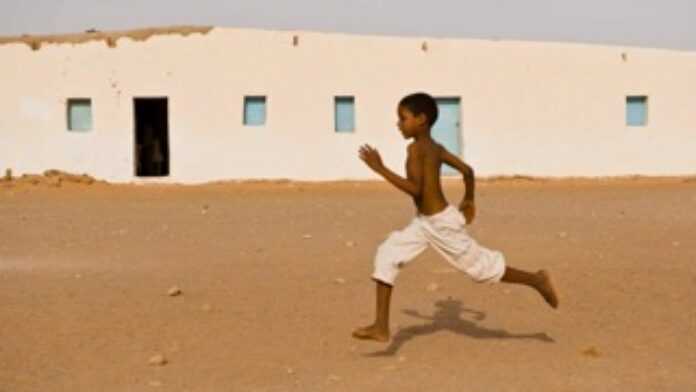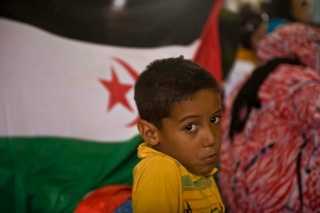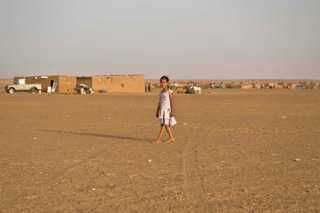
A photographic exhibition marking Refugee Week opened this week in Brighton with images of refugees from one of the world’s longest and most forgotten conflicts. Known as ‘Africa’s last colony’ Western Sahara, was given to Morocco by the Spanish when they withdrew in 1976. A 16 year war followed and a 19 year ceasefire, but the Saharawi’s displaced by the occupation have never been able to return home.
.
 The exhibition – The Thirst of the Dunes – displays images by photographer Robert Griffin and the words by journalist Stefan Simanowitz. The pair spent time in the refugee camps in the desert in April and May 2010 and are keen to raise awareness of the situation of the 165,000 Saharawis who have lived in exile in four large camps in the inhospitable Algerian desert for over 35 years.
The exhibition – The Thirst of the Dunes – displays images by photographer Robert Griffin and the words by journalist Stefan Simanowitz. The pair spent time in the refugee camps in the desert in April and May 2010 and are keen to raise awareness of the situation of the 165,000 Saharawis who have lived in exile in four large camps in the inhospitable Algerian desert for over 35 years.
 Despite efforts by the international community, including over 100 UN resolutions, the referendum promised at the time of the ceasefire has been repeatedly obstructed by the Moroccans who have remained in occupation of roughly three-quarters of Western Sahara.
Despite efforts by the international community, including over 100 UN resolutions, the referendum promised at the time of the ceasefire has been repeatedly obstructed by the Moroccans who have remained in occupation of roughly three-quarters of Western Sahara.
 “I only learned about the the plight of the Saharawi people relatively recently. It is a situation that is hard to ignore, although the international community seems to have no difficulty in doing so” says Griffin. “The refugees in the camps have nothing. They are entirely dependent on external supplies of food and water and face sandstorms and temperatures of 120 degrees – but what makes their lives even worse is that no one knows they are even there.”
“I only learned about the the plight of the Saharawi people relatively recently. It is a situation that is hard to ignore, although the international community seems to have no difficulty in doing so” says Griffin. “The refugees in the camps have nothing. They are entirely dependent on external supplies of food and water and face sandstorms and temperatures of 120 degrees – but what makes their lives even worse is that no one knows they are even there.”
 Through his photographs Griffin has tried to capture a sense of the lives of the Saharawi and their environment. “Despite living in such harsh circumstances they have not lost their sense of humanity, optimism, hope or humour. It was truly a humbling privelige to meet them and I hope that through my photos I’ve captured something of their spirit, generosity and quiet dignity. They have nothing yet they give everything.”
Through his photographs Griffin has tried to capture a sense of the lives of the Saharawi and their environment. “Despite living in such harsh circumstances they have not lost their sense of humanity, optimism, hope or humour. It was truly a humbling privelige to meet them and I hope that through my photos I’ve captured something of their spirit, generosity and quiet dignity. They have nothing yet they give everything.”
 Simanowitz has reported on the situation in the Western Sahara for the Guardian, the Independent, the New Statesman and the Lancet. He also chairs the global campaigning organistion, the Free Western Sahara Network. He believes that the fact that we in Britain benefit from the exploitation of Western Sahara’s natural resources makes it incumbent on us to do something to help resolve the conflict. While in the camps he interviewed many of the refugees and their words accompany the photographs.
Simanowitz has reported on the situation in the Western Sahara for the Guardian, the Independent, the New Statesman and the Lancet. He also chairs the global campaigning organistion, the Free Western Sahara Network. He believes that the fact that we in Britain benefit from the exploitation of Western Sahara’s natural resources makes it incumbent on us to do something to help resolve the conflict. While in the camps he interviewed many of the refugees and their words accompany the photographs.
 “Whilst I can write about their situation, it is much more powerful when the refugees use their own words to describe their lives” says Simanowitz. “You see their courage and their resilliance. One woman for example, a 32-year-old mother of four who was born and raised in the camps told me that how she has nothing in the camps. No work, no water, no land for her goats to graze. But she is not without hope. Greatest of her hopes is to set foot in her homeland for the first time.”
“Whilst I can write about their situation, it is much more powerful when the refugees use their own words to describe their lives” says Simanowitz. “You see their courage and their resilliance. One woman for example, a 32-year-old mother of four who was born and raised in the camps told me that how she has nothing in the camps. No work, no water, no land for her goats to graze. But she is not without hope. Greatest of her hopes is to set foot in her homeland for the first time.”
The exhibition – Thirst of the Dunes – will take place in the newly rennovated Real Patisserie, Western Road, Hove from 16th June – 17th July 2010.
It will then move to the Rosslyn Arms, Hampstead on London 28th July 2010.
The exhibition has been organised by the Free Western Sahara Network.

